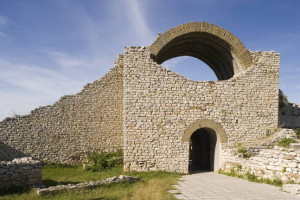WSJ Historically Speaking: Why Walls Rarely Keep Enemies Out
News of the latest theft of sensitive American information— this time of some 4 million records from the federal government’s Office of Personnel Management, allegedly by Chinese hackers—highlights the unfortunate truth about defensive walls. They may offer great psychological comfort, whether as firewalls in the online world or stone walls and natural barriers in the real one, but they rarely work.
In the Book of Joshua, the Israelites engineered a brilliant victory by stamping their feet for seven days and blasting the walls of Jericho with their trumpets. In “The Aeneid,” Virgil described how the Trojans brought about their own downfall by bringing the famous wooden horse inside their gates. In his monumental “The Histories,” Herodotuslauded the courageous but futile last stand of the Spartans at the Battle of Thermopylae (480 B.C.) after they were betrayed by Ephialtes of Malis, who showed the Persians a secret route through the mountains that led to the back of the Greek lines. But these striking failures didn’t deter subsequent generations from believing that walls could keep them safe.
In some cases, mere treachery was sufficient to do the trick. The sack of Rome in 410 A.D. was due in large part to the Romans’ misplaced confidence in the 200-year-old walls surrounding the city. More than 22 feet high and 10 feet wide, the Aurelian Walls were indeed an impressive barrier against potential foes. But all the invading Visigoths had to do was bribe some disaffected slaves to open one of the gates and march straight in. Thus, wrote Edward Gibbon in “The Decline and Fall of the Roman Empire,” “The Imperial city, which had subdued and civilized so considerable a part of mankind, was delivered to the licentious fury of the tribes of Germany and Scythia.”
In other cases, the development of new technology was the key factor. Like Rome, Constantinople was protected by a vast system of walls and gates. But in 1451, the cash-strapped Emperor Constantine XI refused the services of Urban, a Hungarian engineer and cannon-maker, deeming his price too high. Urban promptly offered his skills to the Ottomans instead and built them the largest cannon yet made. For two months, Sultan Mehmed II’s men fired the 29-foot-long behemoth directly at the Gate of St. Romanos. Each night, the city’s defenders did their best to repair the damage, and every day, the Turks made the breach a little wider. On May 29, 1453, Urban’s cannon fired its last shot, destroying not only the ancient walls but the last hope for the thousand-year-old Byzantine Empire.
From China’s Great Wall (started by Emperor Qin Shi Huang in the third century B.C.) to France’s Maginot Line (built in the early 1930s), the chief weakness of defensive walls has always been that where there’s a will, there’s a way round. In 1550, the Mongols under Altan Khan were able to reach Beijing by taking a northeastern route that bypassed the Ming-era Wall entirely, just as the Nazis were able to outflank French defenses by cutting through the Ardennes Forest in Belgium.

